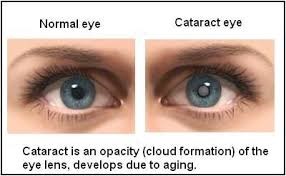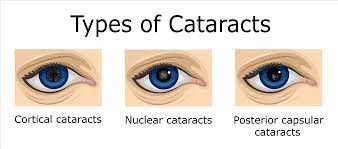
-
Enquiry | Appointment
022-66776677 | +91-8779678354 -
Surgery | Bookings
+91-7208286076 | 022-66776677 -
Email
contact@envisioneyehospital.in
Cataract- An overview
A cataract is a clouding of the normally clear lens of your eye. For people who have cataracts, seeing through cloudy lenses is a bit like looking through a frosty or fogged-up window. Clouded vision caused by cataracts can make it more difficult to read, drive a car (especially at night) or see the expression on a friend's face.
Most cataracts develop slowly and don't disturb your eyesight early on. But with time, cataracts will eventually interfere with your vision. At first, stronger lighting and eyeglasses can help you deal with cataracts. But if impaired vision interferes with your usual activities, you might need cataract surgery. Fortunately, cataract surgery is generally a safe, effective procedure.


How Cataract affects your vision
Who is at the risk of developing cataract?
- If your age is above 50
- If you are on Prolonged use of any steroids
- Excessive exposure to UV rays
- If you are suffering from Diabetes, Hypertension or Cholesterol
- If you get affected by any kind of Eye injuries/Trauma.
- Excessive smoking/consumption of Alcohol
- Obesity
Signs and Symptoms of cataract
- Clouded, blurred or dim vision
- Increasing difficulty with vision at night
- Sensitivity to light and glare
- Need for brighter light for reading and other activities
- Seeing "halos" around lights
- Frequent changes in eyeglass or contact lens prescription
- Fading or yellowing of colours and double vision in a single eye
Causes
Most cataracts develop when aging or injury changes the tissue that makes up your eye's lens.
Some inherited genetic disorders that cause other health problems can increase your risk of cataracts. Cataracts can also be caused by other eye conditions, past eye surgery or medical conditions such as diabetes. Long-term use of steroid medications, too, can cause cataracts to develop.
How Cataract Forms
- The lens, where cataracts form, is positioned behind the coloured part of your eye (iris). The lens focuses light that passes into your eye, producing clear, sharp images on the retina — the light-sensitive membrane in the eye that functions like the film in a camera.
- As you age, the lenses in your eyes become less flexible, less transparent and thicker. Age-related and other medical conditions cause tissues within the lens to break down and clump together, clouding small areas within the lens.
- As the cataract continues to develop, the clouding becomes denser and involves a bigger part of the lens. A cataract scatters and blocks the light as it passes through the lens, preventing a sharply defined image from reaching your retina.
- As a result, your vision becomes blurred Cataracts generally develop in both eyes, but not evenly. The cataract in one eye may be more advanced than the other, causing a difference in vision between eyes.

Cataract types include
- Cataracts affecting the centre of the lens (nuclear cataracts) A nuclear cataract may at first cause more near-sightedness or even a temporary improvement in your reading vision. But with time, the lens gradually turns more densely yellow and further clouds your vision. As the cataract slowly progresses, the lens may even turn brown. Advanced yellowing or browning of the lens can lead to difficulty distinguishing between shades of colour.
- Cataracts that affect the edges of the lens (cortical cataracts) A cortical cataract begins as whitish, wedge-shaped opacities or streaks on the outer edge of the lens cortex. As it slowly progresses, the streaks extend to the centre and interfere with light passing through the centre of the lens.
- Cataracts that affect the back of the lens (posterior subcapsular cataracts) A posterior subcapsular cataract starts as a small, opaque area that usually forms near the back of the lens, right in the path of light. A posterior subcapsular cataract often interferes with your reading vision, reduces your vision in bright light, and causes glare or halos around lights at night. These types of cataracts tend to progress faster than other types do.
- Cataracts you're born with (congenital cataracts) Some people are born with cataracts or develop them during childhood. These cataracts may be genetic, or associated with an intrauterine infection or trauma. These cataracts also may be due to certain conditions, such as myotonic dystrophy, galactosemia, neurofibromatosis type 2 or rubella. Congenital cataracts don't always affect vision, but if they do, they're usually removed soon after detection.
Risk Factors
Factors that increase your risk of cataracts include:
- Increasing age
- Diabetes
- Excessive exposure to sunlight
- Smoking
- Obesity
- High blood pressure
- Previous eye injury or inflammation
- Previous eye surgery
- Prolonged use of corticosteroid medications
- Drinking excessive amounts of alcohol
Prevention
No studies have proved how to prevent cataracts or slow the progression of cataracts. But several strategies may be helpful, including:
- Have regular eye examinations.
- Quit smoking.
- Manage other health problems.
- Choose a healthy diet that includes plenty of fruits and vegetables.
- Wear sunglasses.
- Reduce alcohol use.
WHY YOU CAN CHOOSE CATARACT SURGERY WITH US?
All types of cataract surgeries –Phacoemulsification, Manual Small Incision Cataract Surgery, Refractive cataract surgery and surgery on complicated cataracts – are performed by competent surgeons. The state-of-the-art facilities include:
- High end phacoemulsification system which enables phacoemulsification (Micro incision suture less surgery) under topical anaesthesia
- Microscopes which enable excellent visibility and enhance margin of safety.
- Use of high quality IOLs (manufactured in-house and outsourced from multinational companies) aids to improve postoperative vision and treat refractive conditions like high myopia, presbyopia and astigmatism.
- Advanced surgical instruments which aid in precision during surgery
- Toric planners (Verion) for precise implantation of Toric IOLs
- Zeiss Visulas YAG III plus laser to treat posterior capsular opacification occurring after cataract surgery
- Latest generation optical biometers to accurately calculate intra ocular lens powers in normal eyes and in eyes with pre-existing conditions such as high myopia
- Aberrometers to reassess the biometry with precision, and calculate higher order aberrations.
- Specular microscope and pachymeter which allows to select the correct surgical options for patients
- Digital slit lamp photography unit
- Contrast sensitivity testing equipment
